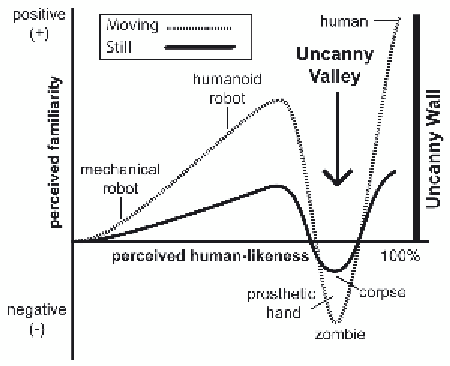Information Technology Reference
In-Depth Information
(Richards, 2008; Weschler, 2002). For realistic
androids, behaviour that is natural and appropri-
ate when engaging with humans, referred to as
“contingent interaction” by Ho, MacDorman, and
Pramono (2008, p. 170), is a key factor in assess-
ing a human's response to an android (Bartneck
et al., 2009; Kanda, Hirano, Eaton, & Ishiguro,
2004). Previous authors (such as Green et al.,
2008; Hanson, 2006; MacDorman et al., 2009;
Schneider et al., 2007) state that the conclusions
drawn from their experiments where still images
had been used may have been different had move-
ment (and sound) been included as a factor.
The perception of the uncanny does not al-
ways have to provide a negative impact for the
viewer (MacDorman, 2006). The principals of
the uncanny theory can work to the advantage of
engineers when designing robots with the purpose
of being unnerving within an appropriate setting
and context. Similarly, the uncanny may help in the
success of the horror game genre for zombie-type
characters. Building on these findings, Tinwell and
Grimshaw (2010) conducted the UM study, using
video clips with sound, to investigate how the
uncanny might enhance the fear factor for horror
games. The results showed that combined factors
such as appearance and sound can work together
to exaggerate the uncanny for virtual characters.
Not only was it suggested that a lack of lip/vo-
calization synchronization reduced how familiar
a character was perceived to be, but a perceived
lack of human-likeness for a character's voice,
facial expression, and doubt in judgement as to
whether the voice actually belonged to the char-
acter or not, also reduced perceived familiarity.
Limitations of Mori's theory
Recent studies demonstrate weaknesses within
the Uncanny Valley theory and suggest it may
be more complex than the simplistic valley shape
that Mori plotted in his original diagram (see
Figure 1). Various factors (including speech) can
influence how uncanny an object is perceived to
be (Bartneck, et al., 2009; Ho et al., 2004; Mi-
nato, Shimda, Ishiguro, & Itakura, 2004; Tinwell
& Grimshaw, 2009). Attempts to plot Mori's
Uncanny Valley shape cannot confirm the two-
dimensional construct that Mori envisaged. The
results from experiments that have been conducted
using cross-modal factors such as motion and
sound imply that it is unlikely that the uncanny
phenomena can be reduced to the two factors,
perceived familiarity and human-likeness, and is
instead a multi-dimensional model (see Figure 2).
Figure 2. The Uncanny Wall, (Tinwell & Grimshaw, 2009)

Search WWH ::

Custom Search